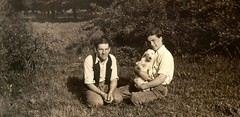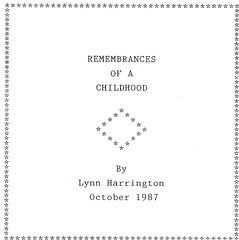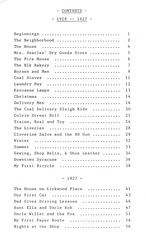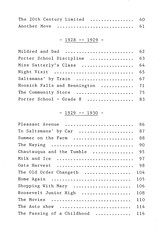Left to right: Jim Harrington, Bonzo, Lynn Harrington
circa 1935
circa 1935
My long-promised new adjunct blog is about ready to roll out for public display. It will feature short excerpts from reminiscences of the first half of the 20th Century, primarily but not exclusively from my Dad, Lynn Harrington (1915 - 1999), and will concentrate on what life was like for a working-class family in the Syracuse area of Upstate New York during that time of rapid change in the routines of daily life.
I plan to have most of the posts for the next year be a serialization of Dad's Remembrances of a Childhood.
(Please click on the images to be taken to legible versions.)
After he retired (and even for about 15 years before), Dad wrote voluminously about his memories, and one little piece of his work has appeared in this blog, wonderfully illustrated by Brian Fies. Like that piece, the episodes in his Remembrances of a Childhood don't dwell as much on family events or extraordinary occurrences as they do on what ordinary daily life was like and his own recollections of its affect on him. This ordinariness -- and its differences from what is considered ordinary today -- makes it more likely to be of interest to people outside the family, but my main goal in "Satchel" will be to digitize Dad's work and thus preserve it for family in the future.
Some of you know that I've been doing a similar thing with his photography: digitizing many of his slides and backing them up (with some commentary) on Flickr. Those slides are from a later time than the stories in "Satchel" will be. Slides can only be taken with a camera, and a camera would have been an unimaginable luxury in the time period from 1918 to 1930 for the working-class Harrington family. I'll try to come up with the occasional illustration -- especially when Dad describes some device or process that is unfamiliar to us now -- but "Satchel" will probably be significantly less graphics-heavy than what I've become accustomed to producing lately. Graphics may be in short supply, but images won't be: Dad was very good at using words as pixels to produce clear pictures in the mind's eye.
The title of the new blog comes from an episode early in Remembrances, and I'm not going to explain it on "Satchel" itself -- I'll leave it as an in-joke for my loyal readers over here:
The transition from horse power to internal combustion engines in the work of transportation, earth moving, and construction did not occur overnight. In my early childhood, up to about 1922 or 1923, horses and wagons made up a considerable share of the traffic on city streets.
We lived a little more nearly in the state of nature then than we do now. When a horse felt a call of nature, he stopped and answered it, no matter where he might be. It was a common occurrence in the city, and we took it quite for granted. We noticed, but thought nothing in particular about, the performance of a little man who walked past our house on his way to and from the street car line which carried him to and from work each day. He carried a brown leather satchel as he walked during the spring and summer months. On his homeward way in the evening, he commonly went out into the street in two or three places, opened his satchel, took out a small scoop, transferred some horse manure from street to satchel, replaced the scoop, closed the satchel, and continued on his homeward way. When I asked Mama why he did that, she said he probably had a nice garden, and used the manure to fertilize it.
"Satchel" will be online sometime on the weekend of June 6th and 7th. A link will be posted here when it's ready.































